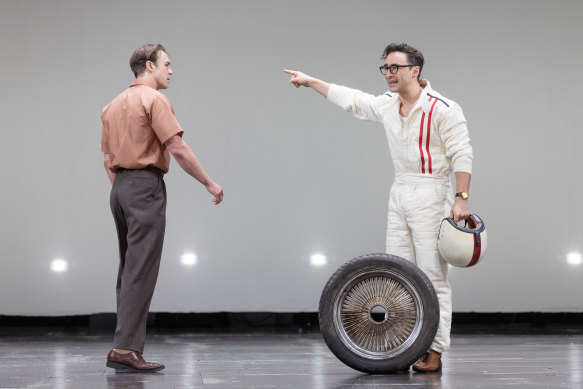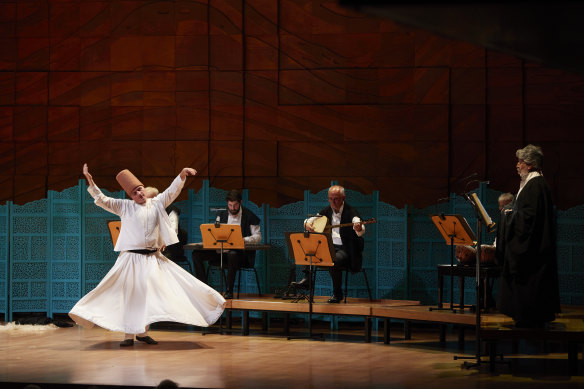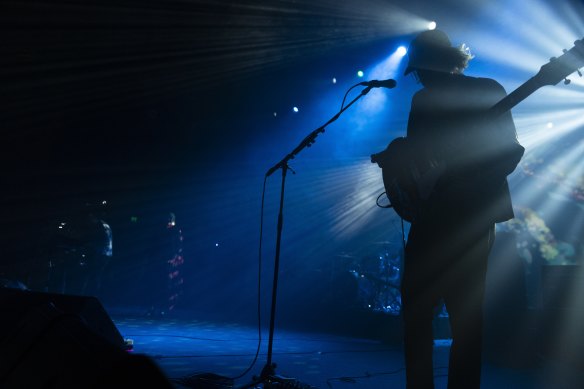- Latest reviews
- Culture
- Live reviews
- Sydney live reviews
Story about the end of the world has moments of theatrical magic
By Em Meller, John Shand and Harriet Cunningham
THEATRE
On the Beach ★★★
Roslyn Packer Theatre, until August 12
Among the wonders of life is that most of us don’t obsess about death until we confront it – and some won’t even then. Death clouds Nevil Shute’s 1957 novel On the Beach, infusing each character with acceptance or denial. Death is inevitable thanks to radiation sickness, humanity having destroyed itself in a nuclear war. With the population of the northern hemisphere already eliminated, those in Melbourne await their inevitable fate.

Contessa Treffone and Tai Hara star in Sydney Theatre Company’s On the Beach.Credit: Daniel Boud
For a planet currently beset with the fires and floods of terminal climate change, pestilence, famine, and a war in Ukraine that could turn nuclear at Putin’s whim, the relevance of an end-of-the-world scenario is chilling. Surely this was reason enough to have confronted us more and reassured us less.
The book’s characters carry on with their lives because it’s the only option, even as you feel death breathing on them at every turn. Where the novel is a disturbing, depressing nail-biter, Tommy Murphy’s adaptation (for Sydney Theatre Company) is lighter: sprinkled with a glitter of hope that partly dilutes the tension.
If it largely shrugs aside a sense of doom, it doesn’t make the mistake that Stanley Kramer’s 1959 film did, of excessively foregrounding the affair between US submariner Commander Dwight Towers (Tai Hara) and party girl Moira Davidson (Contessa Treffone), but it’s no more successful at catching the book’s elusive essence. Too many scenes feel diffused by the big Roslyn Packer stage, and those between Dwight and Moira and between married couple Peter (Ben O’Toole) and Mary Holmes (Michelle Lim Davidson) lack much sense of intimacy.
Yet there are also moments of pure theatrical magic in Kip Williams’ production, including brilliantly effective dream sequences, crowd scenes throwing up looming shadows, and designer Michael Hankin’s non-literal set featuring a vast white gauze that billows as it tracks downstage, creating a poetic radiation cloud.
Hara stands out with his restraint, notably when facing submariner Swain (Elijah Williams), who has jumped ship, desperate to confirm the fate of his parents and girlfriend. So does Matthew Backer as scientist John Osborne, who routinely lights up the stage with his wit.

Matthew Backer (pictured right, with Ben O’Toole) regularly lights up the stage.Credit: Daniel Boud
By contrast, Treffone’s delivery of Moira’s innuendo-laden dialogue is wearing. O’Toole, who recently excelled in A Streetcar Named Desire, is reduced to shouting his way through an overwrought version of Peter Holmes, and his domestic exchanges with Davidson are too arch.
Reviewed by John Shand
MUSIC
Ottoman Baroque
City Recital Hall, until July 29
Ottoman Baroque brings together Western harmonies, traditional Turkish music and the words of 13th-century Persian poet Jalaluddin Rumi. It culminates in the presentation of the Mevlevi ceremony, an ancient and solemn practise by Sufi mystics or, as they are more often described, whirling dervishes.
Exactingly researched and put together by Australian Brandenberg Orchestra artistic director Paul Dyer, in collaboration with traditional musicians and representatives of the International Mevlana Foundation, Ottoman Baroque is a thoughtful construction of music and ideas.
But is it a performance? This, and many other questions, remain after seeing the first of seven near sell-out shows in Sydney.

Ottoman Baroque is more of a religious ceremony than a concert.
The first half is anchored by three contemporary choral settings of Rumi’s poem, This Marriage. In one, the Brandenburg Choir produce seamlessly blended sounds in the eight-part harmonies of Ed Newton-Rex (written for Prince William’s wedding) and a newly commissioned work from Australian composer Joe Twist.
The clarity of tone, scrunch of close harmonies and heartwarming words fill the hall with love, so it comes as something of a rude shock to then be immersed in the complex tones and ascetic flow of Taksim I, another new work, commissioned from Hugh Ronzani for period instrument specialists of the Brandenburg Orchestra and their Turkish colleagues, as a link between the dense vocal harmonies of the choir and the meandering, linear melodies of the traditional music.
Taksim 2, also by Ronzani, brings together baroque flute and its Turkiye equivalent, the ney, with the ethereal whisper of the viola d’amore. Interlaced between these are two austere traditional works from the 17th century and the simple but high-energy Nihavend Longa, by Kemani Hanim Kevser.
In the second half the Brandenburgers make way for the musicians and holy men of the Mevlana Foundation. The Samizen, in their white robes and tall camel felt hats, spin around the stage of City Recital Hall as the band plays traditional melodies and improvisations.
It’s by turns bewildering, beautiful and an almost uncomfortably intimate glimpse of reaching out to the divine. Where does ritual end and performance begin? No answers here, but Ottoman Baroque is, at the very least, a welcome provocation.
Reviewed by Harriet Cunningham
MUSIC
Slowdive ★★★★½
Enmore Theatre, July 21
What does it mean to feel nostalgia for a song released before you were even born?
Enmore Theatre is at capacity for Slowdive’s first show in Sydney since 2018, after they cancelled their scheduled set at Daydream festival back in April due to injury.

Slowdive are one of the progenitors of shoegaze.Credit: Rhett Wyman
The crowd at the Enmore is varied: grey-haired guys in Pink Floyd T-shirts, baby-faced teens still wearing braces and at least one dude in speed dealers lighting up the moment the lights went down.
This is the strangeness of Slowdive. The influential shoegaze band broke through in the early ’90s and broke up soon after. Almost two decades later, in 2014, they got back together, and released Slowdive in 2017, their most successful album.
They’re not the first band to break up and get back together, or to find a new audience over time. But it is unusual how easily they have reached over that divide –1995’s Pygmalion might have been made this year, and Slowdive in 1991. The strange alchemy of their songwriting hasn’t just stood the test of time, but defied its logic. It has also influenced countless other acts, including Beach House, Deerhunter and Tame Impala.

Slowdive broke up for almost 20 years, before triumphantly returning to the scene in 2014.Credit: Rhett Wyman
Their set list on Friday moves back and forth through the years, no one era favoured. But that’s not to say Slowdive has not grown or changed. The gritty Avalyn builds intensely – it is beautiful, melancholic and near-deafening. And then there is Star Roving, which draws on those grittier elements and reassembles them into something dreamier. Even the subtlety of these shifts suggest songs that belong on one continuum.
In a 2015 Pitchfork documentary, singer and guitarist Neil Halstead said it always made sense to him that teens “got” Slowdive. Hearing Sugar for the Pill (“this jealousy will break the whole”), Catch the Breeze (“rain, washes, ways down”), kisses (“taking all the ghosts, the hurt”), it’s easy to see what he means. There is the angst, the catastrophe of heartbreak, the pairing of the celestial with ennui – storms, hauntings, stars and woundedness. It may sometimes feel like music for teens, but it respects the complexity of those experiences, so that it still has a place in your record collection decades later.
Maybe that’s part of why their music has endured. And that’s how you end up with a crowd of people born 30 years apart, experiencing the same nostalgia, and screaming “I love you” at the stage.
Reviewed by Em Meller
The Booklist is a weekly newsletter for book lovers from books editor Jason Steger. Get it delivered every Friday.